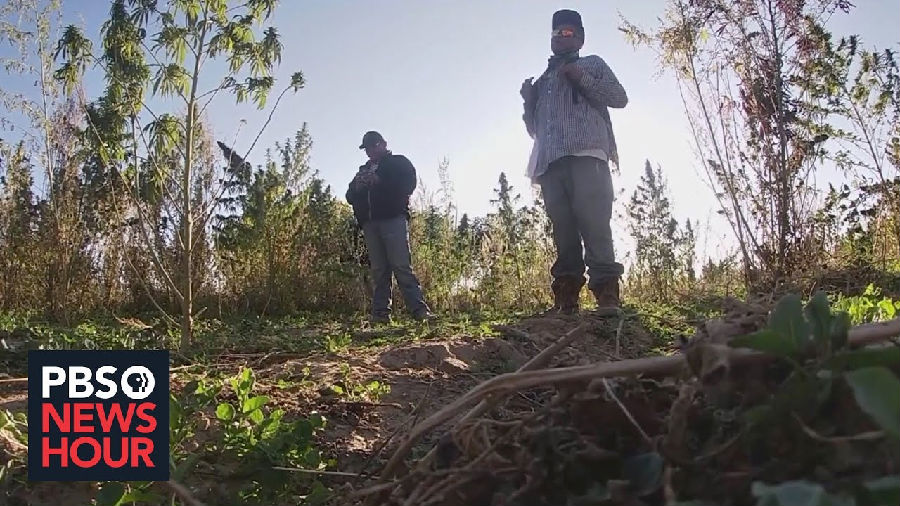JUDY WOODRUFF: Now to a very different story. Cannabidiol, or CBD, products are everywhere right now, and the growing trend isn't only fashionable. It's also big business. It can be derived from both hemp and cannabis, with the hemp extraction used to produce fabrics, oils and food. From the Cronkite School of Journalism at Arizona State University, Marcella Baietto spoke to one Navajo leader who before the pandemic who has jumped at this growing business opportunity, but some within his own tribe are saying, not so fast.
MARCELLA BAIETTO: In the heart of the Navajo Nation, not far from the four corners where Arizona, New Mexico, Colorado, and Utah meet, millions of hemp plants are growing, many of them ready to be harvested. It's the first time this kind of plant is being grown on such a massive scale on the Navajo Nation. Hemp plants contain less than 3 percent of THC, so they cannot get you high, but Dineh Benally says the crop provides his community with a natural health and wellness product.
DINEH BENALLY, President and Owner, Navajo Gold: Doing this project, I really got to know what our people are really made of, what type of skill set and what kind of issues we're dealing with, alcoholism, methamphetamines, opiate abuse.
MARCELLA BAIETTO: Harlan Joe is a manager on the farm, and he's struggled with substance abuse. He says life on the farm has given him a second chance at life.
HARLAN JOE, Crew Leader, Navajo Gold: I used to be alcoholic, true. I used to be on the streets drinking around Shiprock. And when Dineh told me to take over, it changed my life, you know.
DELBERT ATCITTY, Employee, Navajo Gold: Just getting the buds.
MARCELLA BAIETTO: The farm is providing job opportunities for nearly 100 employees, like Delbert Atcitty, in a community that has high unemployment.
DELBERT ATCITTY: We're actually standing here and doing this right here just because we believe in something that couldn't be done.
MARCELLA BAIETTO: This hemp will eventually become the main ingredient in Navajo Gold products, the CBD company Benally started in early October.
MAN: This can replace that.

MARCELLA BAIETTO: The new harvesting and processing of the hemp all takes place on the Navajo Nation. Hemp plants like these are turned into lotions, oils and even edibles...
ANTHONY LEE, Plant Health Advocate: It doesn't have to be smokable.
MARCELLA BAIETTO: with CBD oil, a substance derived from hemp that is not intoxicating, but which many believe helps with medical issues like arthritis and anxiety. Navajo Gold employee Anthony Lee calls himself a plant health advocate, and says the Navajo Nation is an ideal place to grow this crop.
ANTHONY LEE: We have land and we have water. For instance, we only use about 20 percent of the farmland located along the San Juan River.
MARCELLA BAIETTO: On his 300 acres, Benally and his farmers can grow up to 2.5 million hemp plants. But this crop comes with some caveats. The U.S. Agriculture Department and tribal lands have new regulations around the farming of hemp. These include sample testing of the plants to ensure their THC levels are low enough to be considered hemp, and a plan to dispose of any plants that tests too high. And Navajo leaders, like President Jonathan Nez, say Benally must follow the new federal rules and get permission from the nation to raise a hemp crop.
JONATHAN NEZ, President, Navajo Nation: We just want to be able to do it correctly and protect our Navajo people that want to utilize that product on our nation.
MARCELLA BAIETTO: Benally says he will work to ensure he is meeting the new federal and tribal guidelines, and he understands cooperation ensures success.
DINEH BENALLY: We have to work together. That's all I realize. I -- to get this going and take it to the next level.
MARCELLA BAIETTO: And Benally hopes that next level means seeing more of this green across the red sandstone of the Navajo Nation. For the "PBS NewsHour," I'm Marcella Baietto with Cronkite News in Shiprock, New Mexico.












